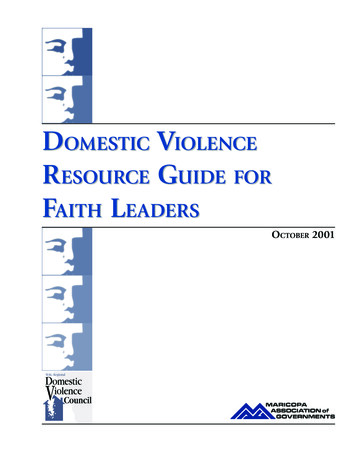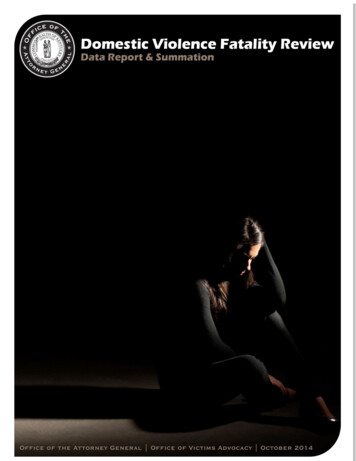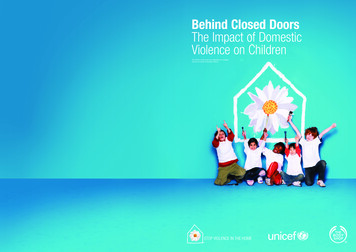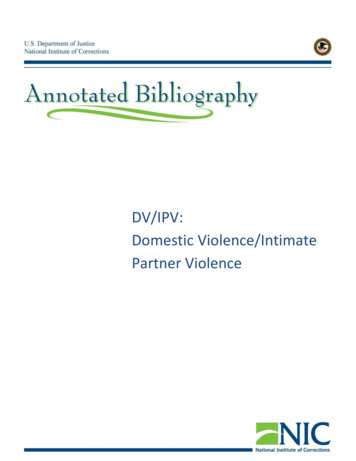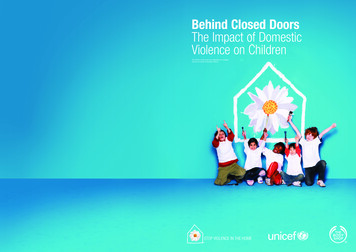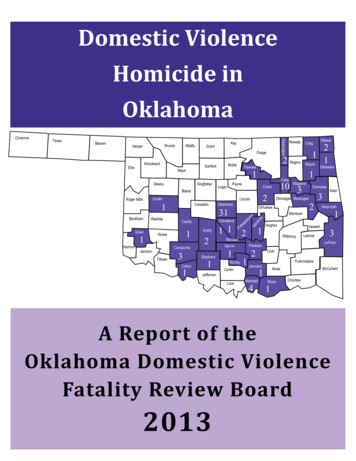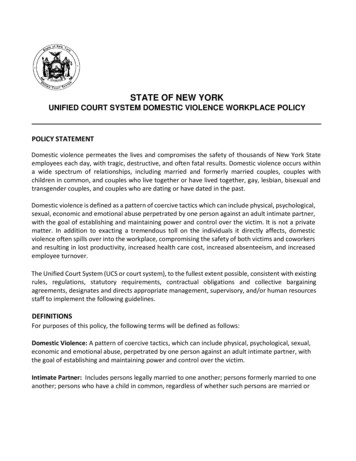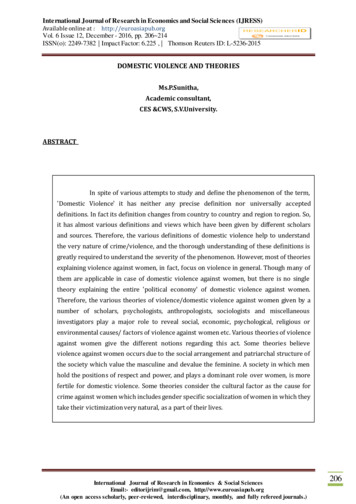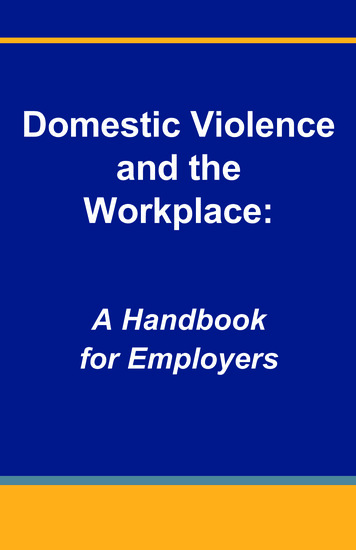
Transcription
Domestic Violenceand theWorkplace:A Handbookfor Employers
INTRODUCTIONDomestic violence compromises the safety of thousandsof New York State (NYS) employees every day, with tragic,destructive and often fatal results. This handbook is designedto help create an informed, supportive workplace culture andto assist managers, supervisors and co-workers in recognizingpossible signs of domestic violence.It is recommended that all public agencies and privateorganizations develop and implement a domestic violenceand the workplace policy.Upon hire, all employees should receive and sign a copyof the policy, acknowledging that they have read thedocument and understand where to go if they are beingabused by a current or former partner and/or if they areconcerned that a coworker may be a victim of domesticviolence. When an organization provides all employeeswith domestic violence information as part of the standardhiring practice, employees who are being abused are lesslikely to feel singled out and may be more receptive toseeking assistance. Additionally, such a proactive approachto domestic violence in the workplace is a preventive effortand communicates to all employees that the employer iscommitted to maintaining a safe and healthy environment foreveryone, which sets a tone of professionalism, respect andzero tolerance for violence of any kind in the workplace.An essential component of any domestic violence and theworkplace policy should include contact information forlocal domestic violence service providers who specialize inassisting victims. These services are provided at no cost tothe employee or the employer. Once identified, employeeswho need assistance should be connected with the localdomestic violence service providers.1
Why has domestic violence become a workplace concern?Workplace Safety Employers must providethe safest workplaceDomestic violence threatenspossible for victims ofcompany employees and poses adomestic violence and thethreat to the safety of the workplace.entire workforce. This isparticularly challengingwhen an employee isa victim of domestic violence, since, even though an abuser’sprimary victim is at greatest risk of harm, all the people withwhom that victim comes into contact, including coworkers andprofessional acquaintances – are potential secondary victims.More than one million women and 371,000 men are victims ofstalking in the U.S. each year.1 Stalkers often follow the victimto the workplace, creating the potential for an unsafe workenvironment. In addition, the risk of violence often escalateswhen a victim leaves the relationship, and work may be the onlyplace the perpetrator can find them. Intimate partner assaults orhomicides that occur in the workplace often include collateraldamage with other employees being injured or killed.It Affects Many Employees 1 in 4 women will experience some level of domestic violencein their lifetime.2 Domestic violence also happens to men andoccurs in same-sex relationships. While some male victims ofdomestic violence are abused by female partners, the majorityof male victims are abused by other men. Learn more from theNational Coalition Against Domestic Violence’s handout, MaleVictims of Violence, at s-of-abuse-too/.More than one million people report a violent assault by anintimate partner every year in the U.S.31 U.S. Department of Justice, National Institute of Justice (2000). Full Report of the Prevalence, Incidence and Consequences of Violence Against Women. November, NCJ-183781.2 Tjaden, Patricia & Thoennes, Nancy. National Institute of Justice and the Centers forDisease Control and Prevention, “Extent, Nature and Consequences of Intimate PartnerViolence: Findings from the National Violence Against Women Survey,” (2000).3 U.S. Department of Justice, Bureau of Justice Statistics, (2000). Intimate Partner Violence.NCJ 178247.2
A phone survey by the Corporate Alliance to End PartnerViolence (CAEPV) of 1,200 full-time American employees foundthat 21 % of respondents identified themselves as victims ofintimate partner violence and 44% of full-time employed adultspersonally experienced domestic violence’s effect in theirworkplaces.4In a survey of senior corporate executives, 56% reported they wereaware of an employee who has been affected by domestic violence.5Security and Liability Employers must provide a safe work environment for allemployees and can be held liable if they fail to do so. Juryawards for inadequate security suits average 1.2 millionnationwide and settlements average 600,000.6Ninety-four percent of corporate security directors surveyed rankdomestic violence as a high security problem at their company.7Health Care Employers have a legal obligationto protect the rights of victims ofdomestic violence.The Center for Disease Control and Prevention (CDC) reports“costs of intimate partner violence (IPV) against women alone in1995 exceeded an estimated 5.8 billion. These costs includednearly 4.1 billion in the direct costs of medical and mental healthcare and nearly 1.8 billion in indirect costs of lost productivity.When updated to 2003 dollars, IPV costs exceed 8.3 billion,which included 460 million for rape, 6.2 billion for physicalassault, 461 million for stalking, and 1.2 billion in the value oflost lives.”8Higher health care costs are passed on to all employees andemployers in the forms of increased premiums and higher co-pays.4 CAEPV National Benchmark Telephone Survey. 2005. Bloomington, IL: Corporate Allianceto End Partner Violence. Available at: http://www.caepv.org/getinfo/facts stats.php?factsec 35 Patrice Tanaka & Company, Inc. (October 16, 2002). News Release: Corporate LeadersSee Domestic Violence as a Major Problem That Affects Their Employees According toBenchmark Survey by Liz Clairborne, Inc. Contact Lauree Ostrofsky (212) 229-0500, x 236.6 Perry, P. (1994). Assault in the workplace. Law, May 1, 41.7 National Safe Workplace Institute Survey, as cited in Solomon, C.M. (1995). Talking franklyabout domestic violence. Personnel Journal, 74, 64-66.8 Center for Disease Control and Prevention at: nerviolence/consequences.html3
Performance & Productivity A study of female employees in Maine who experienceddomestic violence found that:ŊŊ 98% had difficulty concentrating on work tasks;ŊŊ 96% reported that the domestic violence affected their abilityto perform their job duties;ŊŊ 87% received harassing phone calls at work;ŊŊ 78% reported being late to work because of the abuse;ŊŊ 60% lost their jobs due to domestic violence.9 In a telephone survey from CAEPV:ŊŊ 64% of the respondents who identified as victims of domesticviolence indicated that their ability to work was affected by theviolence:–– 57% said they were distracted;–– 45% feared that colleagues would find out;–– 2 in 5 were afraid of their intimate partner’s unexpectedcontact (in person or by phone).10 A study about women’s experiences with violence, based on anational telephone survey of 8,000 women, found that womenexperiencing physical intimate partner violence victimizationreported:ŊŊ An average of 7.2 days of work-related lost productivity; andŊŊ 33.9 days in productivity losses associated with householdchores, child care, school, volunteer activities, and social/recreational activities.119 Ridley, E, Rioux, J, Lim, KC, Mason, D, Houghton, KF, Luppi, F, Melody, T. 2005. DomesticViolence Survivors at Work: How Perpetrators Impact Employment. Maine Department ofLabor and Family Crisis Services. Available at: http://mainegov-images.informe.org/labor/labor stats/publications/dvreports/survivorstudy.pdf10 CAEPV National Benchmark Telephone Survey. 2005. Bloomington, IL: Corporate Allianceto End Partner Violence. Available at: http://www.caepv.org/getinfo/facts stats.php?factsec 311 Arias I, Corso P. 2005. Average Cost Per Person Victimized by an Intimate Partner of theOpposite Gender: a Comparison of Men and Women. Violence and Victims, 20(4):379-91.4
What is domestic violence?Domestic violence is oftenVictims may be controlledmischaracterized as familyand terrorized and never beviolence which can include theabuse of children by parentsphysically assaulted.and the abuse of elderly orolder parents by adult oradolescent children. Domestic violence is also often referred to asintimate partner violence. However, for the NYS Domestic Violenceand the Workplace initiative, Domestic Violence is defined as thefollowing:Domestic Violence is a pattern of coercive tactics, which caninclude physical, psychological, sexual, economic and emotionalabuse, perpetrated by one person against an adult intimate partnerwith the goal of establishing and maintaining power and controlover the victim.What does it look like?Often people think of domestic violence as physical or sexualassault. While that is true, it is only part of the picture. Many victimsare never physically or sexually assaulted but are controlled andterrorized by their partners using non-physical tactics such as: Verbal, emotional/psychological abuseCoercion and threatsIsolationMinimizing, denying, blamingUsing childrenIntimidationEconomic abuseWhat does it look like in the workplace?Colleagues, managers and supervisors may detect a pattern ofone or more of the following signs/ behaviors in the workplace thatMAY be an indicator of domestic violence: Visible physical injuriesStress-related illnesses5
Marital or family problemsAlcohol or other addictionsDepression, suicidal thoughts or attemptsAbsenteeism, lateness, leaving work early, arriving earlyStrict adherence to starting and ending timesInability to travel away from the office for work related eventsDecreased job performanceUnusual/excessive number of phone callsDisruptive personal visitsAbrupt changes in personality, including isolating from othercoworkers and lack of participation in office functions/eventsFatigueIf you see or suspectsomething, say something.What can I do?The presence of the signs/behaviors listed above does not meanthe employee is definitely a victim of domestic violence. However,if you are a manager or supervisor and you notice these signsin your employee, or if you have other reasons to suspect thatthey might be a victim of domestic violence, it is time to ask somequestions, in private, away from other staff. For example: “Is there anything going on at home that is making it hard foryou to get to work, or get to work on time?”“I notice there has been a change in your performance.Is there anything going on at home that is impacting yourperformance?”“I’ve noticed you’re getting a lot of upsetting phone calls. Isthere something we can do to assist with that?”If you are a concerned co-worker, you might want to say: 6“I’m concerned about you. If I can be of any help, please letme know.”“I heard you crying when you hung up the phone this
morning. Do you feel like talking about it? I would like to helpyou get the support you need.”“I noticed your split lip and the bruise on your arm. I’mconcerned for your safety and I’d like to help.”Asking these questions and making these statements might beuncomfortable at first, and employees may not readily admit thatthere is anything wrong. However, by speaking with the employee,you are sending themessage that you haveseen something, you areDoing nothing sends the messagesaying something, and youthat the workplace doesn’t care.are willing to assist them ifand when they are ready.While they may not be opento assistance when you first speak to them, you have planted theidea that someone has noticed and is available to help.If we say nothing, we are sending the message to our colleaguethat they are on their own and we don’t want to be involved.Ultimately, by not saying anything we are reinforcing theperpetrator’s control and dominance. Reaching out conveys themessage that they are not alone.It is important to note that not all employees will feel comfortable orable to help victims in the same way. It is ok to feel unprepared orunsafe when you think about reaching out to a victim of domesticviolence. Employers should identify an employee (or severalemployees) who has had some domestic violence training as a “goto” person in the domestic violence and the workplace policy. Thisperson should be available if one employee has concerns aboutthe safety of another employee.What if they confirm they are experiencing domesticviolence? Let the employee know that you are concerned for their safety.ŊŊ “I’m concerned for your safety. I’d like to help if I can.”ŊŊ “I’m worried about you. It sounds like you may not be safe.”ŊŊ “Your situation sounds dangerous. I’m concerned for yoursafety.”7
Validate their experience and let them know that you believe them.ŊŊ “You are not alone. This happens to lots of people.”ŊŊ “You are not to blame. It’s not your fault.”ŊŊ “You are not crazy. Yourfeelings are normalSafety planning is essential. Developand reasonable fora workplace safety plan and refersomeone who’s beenthe employee to your local domesticthrough what you’veviolence service provider.been through.”ŊŊ “It sounds like youhave good reason to be afraid”ŊŊ “Help is available. I’d like to help if I can.”Refer the employee to the local domestic violence serviceprovider and to an employee assistance program if one isavailable.Provide support for the employee’s decision. Don’t judge thesuccess of your intervention by the employee’s action andremember that there are risks attached to every decisiona victim makes. Be patient and respectful of a victim’sdecisions, even if you don’t agree with them.Provide them with a copy of Finding Safety & Support (www.opdv.ny.gov/publications/index.html). This is a comprehensiveguide for survivors and helpers with up-to-date informationabout adult domestic violence, safety planning, and gettinghelp from domestic violence services, the police, and the courts.What shouldn’t I do? 8Never suggest that an employee go home and pack theirbags and leave. Leaving is a very dangerous time for a victimof domestic violence. At this critical time violence oftenescalates and/or domestic violence homicides occur. It isessential to have a safety plan in place prior to leaving. If anemployee is in imminent danger, suggest that they use yourphone to call the police or the local domestic violence serviceprovider. The provider can help them leave in an emergencyas safely as possible.Don’t ask questions that judge the employee’s choices:ŊŊ Why don’t you just leave?ŊŊ Why did you go back?ŊŊ Why did you wait so long?
Remember, leaving can be very dangerous and may not bethe best immediate choice.Don’t suggest marriage or family counseling. Services thatrequire victims to participate in joint sessions with theirabusive partners increase a victim’s risk of physical andemotional harm and are therefore not recommended fordealing with domestic violence.Don’t do “nothing.” Silence sends the wrong message and canbe more hurtful than if you should say something awkward.Why doesn’t the employee leave the situation?Many people who are abused by their intimate partners don’t wantthe relationship to end, they want the abuse to end. Even underthe best of circumstances, it is not easy to end a relationship withan intimate partner.Living with the trauma of domestic violence, victims are oftentrapped by circumstances, feelings, thoughts and social norms.9
Love, family, shared memories and commitment are bonds that arehard to break.There are risks attached to every decision a victim of domesticviolence makes and the risks of leaving often outweigh the risks ofstaying. Seeking help or deciding to leave only makes sense to avictim when it reduces the overall risks to the victims and their family.You may never fully understand all the factors that go into a victim’sdecision to remain with an abuser, but offering unconditionalsupport and assistance is something you can do regardless ofwhether the victim and abuser remain together.Who are domestic violence service providers?The good news is that the workplace does not need to be anexpert in domestic violence. In NYS there are professionals—localdomestic violence service providers—in every county. Theseprograms are free and confidential to everyone seeking assistance,and providers are available to assist employees in developing apersonal safety plan whether they are planning to stay with theirpartner or leave their partner. Safety planning is a process ofevaluating the risks and benefits of different options and identifyingways to maximize safety and minimize risk.In addition to emergency hotlines, local domestic violenceprograms also offer: 10Shelters and emergency housing;Counseling and support groups;Services for children;Emergency transportation;Assistance initiating services such as health insurance andSNAP;Help getting medical care, legal services;Help with housing, furniture and clothing;Help finding employment;Assistance with the completion of Crime Victims Assistancecompensation forms.
Employees can utilize program services even if they remain in thehome with their partner.To locate the local domestic violence service provider in yourcounty visit http://www.nyscadv.org/statewide-dv-directory or callthe NYS Domestic and Sexual Violence Hotline at 1-800-942-6906.You don’t have to be an expert indomestic violence. You just need torefer employees to the people in thecommunity who are!What is our legal responsibility? New York State has established that victims of domesticviolence are now a protected class in the employmentprovisions of NYS Human Rights Law. This law prevents anemployer from firing or refusing to hire any individual basedon their status as a victim of domestic violence and preventsdiscrimination in compensation or in the terms, conditions orprivileges of employment. [Executive Law § 296(1)(a)]New York State law makes it a crime for employers topenalize an employee who, as a victim or witness of acriminal offense, is appearing as a witness, consulting witha district attorney, or exercising his/her rights as providedin the Criminal Procedure Law, the Family Court Act, andthe Executive Law. This law requires employers, with priorday notification, to allow time off for victims or subpoenaedwitnesses to exercise his/her rights as provided in theCriminal Procedure Law, the Family Court Act, and theExecutive Law [Penal Law §215.14].New York State law provides that a victim of domesticviolence who voluntarily separates from employment may,under certain circumstances, be eligible for unemploymentinsurance benefits. [§593 of NYS Labor Law]11
Domestic violence and the workplace policyWhy do organizations such as government agencies, not-forprofit service providers, businesses and other groups need aformal policy on domestic violence? Domestic violence victimsand perpetrators can befound in an organization’sHaving a formal policy lets employeesclient population, staff andknow that you have a plan in place tostakeholders, whetherassist victims.or not they are formallyidentified. For some organizations, identifying domestic violencevictims and perpetrators, and working with them, is part of theirdaily mission. For others, domestic violence may be a hiddenproblem, and the individuals, whether they are clients or staff, lessidentifiable. Whatever the case, if organizations lack awareness ofhow to identify domestic violence, and do not create guidelinesand policies for how to respond appropriately, they can unwittinglyendanger and isolate both clients and staff, as well as inadvertentlyenable abusive behavior. The New York State Office for thePrevention of Domestic Violence (OPDV) strongly recommends thatevery workplace develop a Domestic Violence and the Workplacepolicy. This will communicate workplace practices that will promotesafety in the workplace and respond to the needs of victims ofdomestic violence. In addition it will set a tone by communicatingthat domestic violence will not be tolerated and that informationand support will be provided to all employees.Policies should include the following: 12Policy Statement – Outline the purpose of the policy and thecommitment of the company to uphold the policy.Definitions – Clearly define the domestic violence terms usedthroughout the policy.Employee Awareness – State what the employer will do tomake certain that employees have the information they needabout domestic violence and the company policy.Non-Discriminatory and Responsive Personnel Policiesfor Victimized Employees – Mention NYS laws that protectvictims of domestic violence, and develop company policy onthings such as documentation, performance issues directlyrelated to domestic violence, and time and attendance issues.
Workplace Safety PlansŊŊ Emergency Workplace Safety Plan – Develop a clearstatement on what is expected of employees if theywitness violent or threatening behavior on companyproperty.ŊŊ Personal Workplace Safety Plan – Outline what thecompany is willing to do, with the input of the employee, toassist them with safety issues in the workplace. ŊŊ Provide clear directions/information about how orders ofprotection will be handled.Accountability for Employees Who Are Offenders – Developa clear accountability statement for employees who usecompany resources to commit an act of domestic violence,negatively affect victims, or assist perpetrators.Firearms – If any company employees carry firearms, includerelevant NYS and federal laws.Training – Outline the domestic violence training plan forcompany employees.Company Responsibility – Clear statement regardingconfidentiality for the victim and the information shared.A Model Domestic Violence and the Workplace Policy for PrivateBusiness can be found at icy.htmlGuiding Principles for Community Domestic Violence Policies canbe found at idingprinciples2013.pdfFor technical assistance with policy development, NYSbusinesses should contact OPDV at opdvdvworkplace@opdv.ny.govWorkplace Safety Plan MeetingUpon notification that an employee is in need of a workplacesafety plan, and/or upon submission of an order of protection(OP), the appropriate staff person(s) will meet with theemployee to assist with the development and implementationof an individualized workplace safety plan.The Guidelines on the following pages will assist employerswith that meeting.13
Domestic Violence and the WorkplaceSafety Plan Meeting GuidelinesIn accordance with the Domestic Violence and the Workplace Policy,all efforts will be made to assist an employee who comes forward witha domestic violence issue.ADVISEADVISE THE EMPLOYEE THAT: The agency/company wants to support them and enhance their safety in the workplace. Confidentiality will be maintained to the extent possi-ble. Limitations may exist if it is determined that maintaining confidentiality puts the victim or others at riskof physical harm, is required by law, or deemed necessary to enforce an order of protection (OP). Disclosureswill be kept to a minimum to ensure safety, and theemployee will be notified of any disclosures that occur.(See policy for additional confidentiality guidelines.)ASKASK THE EMPLOYEE: How can we best support you? Are you receiving threatening calls/emails at work? Are you being followed to work and/or is the individual 14coming to your worksite?Does the individual work in the same agency/companyand/or building?Do you have an order of protection? If yes:ŊŊ Review the agency/company OP procedure with theemployee and encourage them to always keep a copy ofthe OP with them.ŊŊ Ask if they want to provide a photo of the individual sothat it can be provided to security and/or appropriatestaff.ŊŊ Ask if they would like someone within their worksite toknow about the situation to better assist them shouldthe need arise.ŊŊ Ask the employee to notify you immediately if there areany changes, including cancellation or expiration, of the OP.
DISCUSSDISCUSS POSSIBLE OPTIONS. When appropriate andwith the employee’s agreement, the agency/companymay be able to: Set up procedures for alerting security and/or police. Temporarily relocate the employee to a secure area. Alter the employee’s work schedule. Change the employee’s email address. Change the employee’s phone number/block number/screen calls. Reassign the employee’s parking space. Provide the employee with escorts to and from thebuilding. Accommodate a voluntary transfer or permanent relocation to new worksite.Please consult policy for additional guidelines on providingoptions.CONFIRMCONFIRM that the employee has been referred toEmployee Assistance AND to their local domestic violence service provider. Offer the employee a copy ofFinding Safety & Support. (Be certain to point out therisks of the offending individual finding the publication.)DOCUMENTDOCUMENT details of your discussion and the components of the agreed-on safety plan.FILEFILE the OP in accordance with agency/companyDomestic Violence and the Workplace Policy, and filedocumented notes in a separate file in a secure location.The New York State Office for the Prevention of Domestic Violence(OPDV) is available to assist you with domestic violence policy development and domestic violence and the workplace training. In addition, OPDVwill provide technical assistance for any domestic violence issues thatarise in the workplace. Please contact Joan Faxon at joan.faxon@opdv.ny.gov, or call 518-457-5740.If it is determined that an employee is utilizing agency/company resourcesto victimize anyone, consult management.15
NOTES16
If you would like permission to use any part of this publication, please put your request in writing tothe attention of the Public Information Officer at opdvpublicinfo@opdv.ny.gov. Please identify thesection requested, how it will be used, and where it will be published. This material cannot be reprintedwithout the express authorization of the New York State Office for the Prevention of DomesticViolence.1-800-942-6906NYS Domestic & Sexual Violence HotlineCONFIDENTIAL24 HRS/ 7 DAYSEnglish & español, multi-language accessibility711: Deaf or Hard of HearingIn NYC: 311 or 1-800-621-HOPE (4673)TDD: 1-800-810-7444The Hotline responds to and is a resource for victims of domestic andsexual violence, concerned others, and professionals, 24 hours a day,seven days a week. Funded by the New York State Officefor the Prevention of Domestic Violence, the hotline provides trainedcounselors who respond to a variety of service needs, including: crisisintervention, supportive counseling, information and referral services, andtechnical support to providers. Call the Hotline to find domestic violenceprograms by county or get a list online /New York State Office for the Prevention of Domestic Violence(518) 457-5800Fax (518) 457-5810www.opdv.ny.gov17
To order additional copies of this handbook, and/or FindingSafety & Support, visit order.html18
The Center for Disease Control and Prevention (CDC) reports "costs of intimate partner violence (IPV) against women alone in 1995 exceeded an estimated 5.8 billion. These costs included nearly 4.1 billion in the direct costs of medical and mental health care and nearly 1.8 billion in indirect costs of lost productivity.


